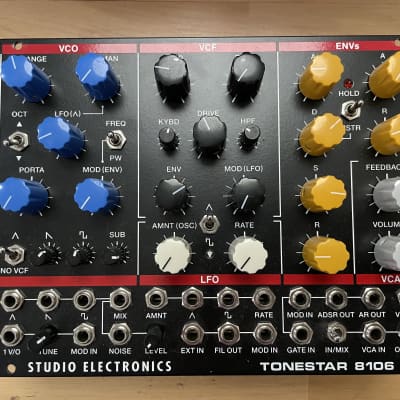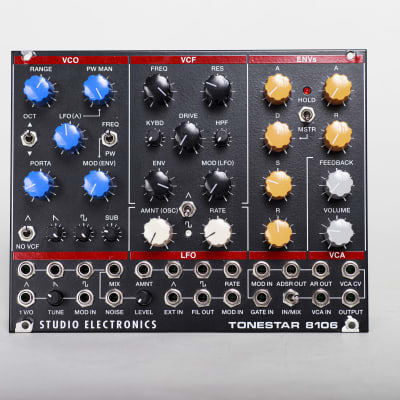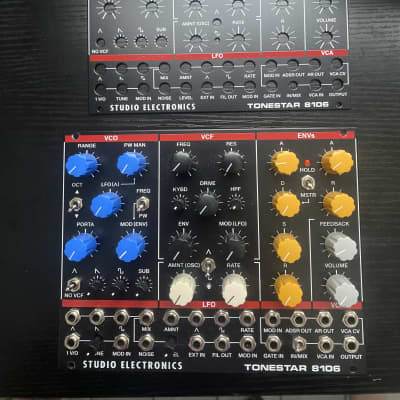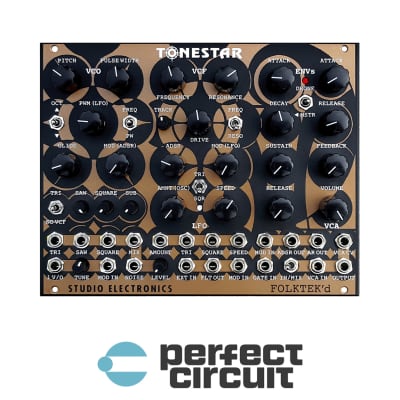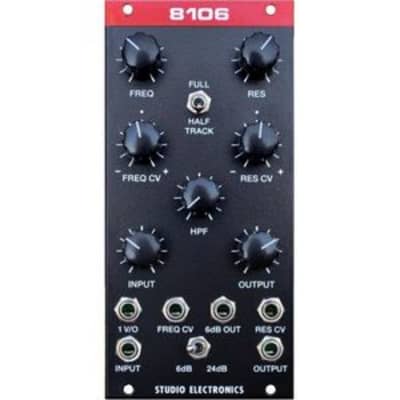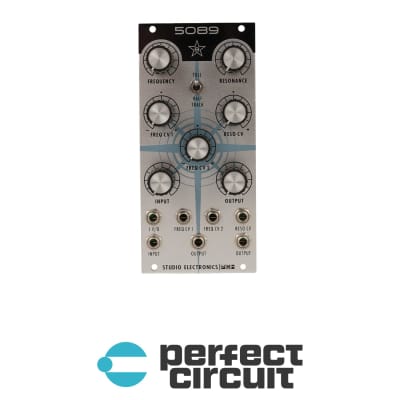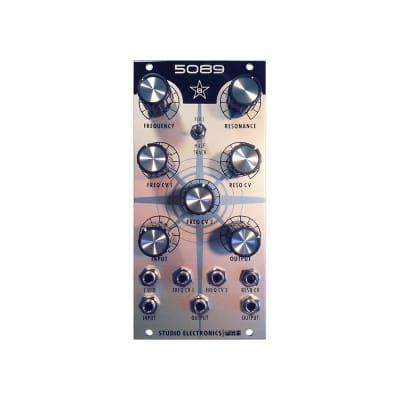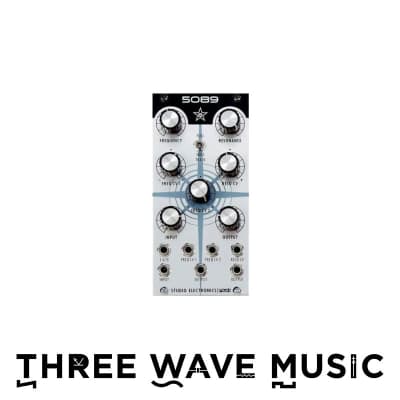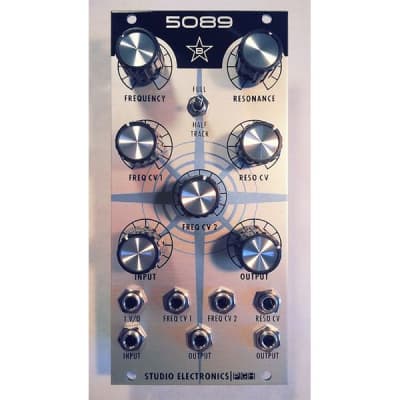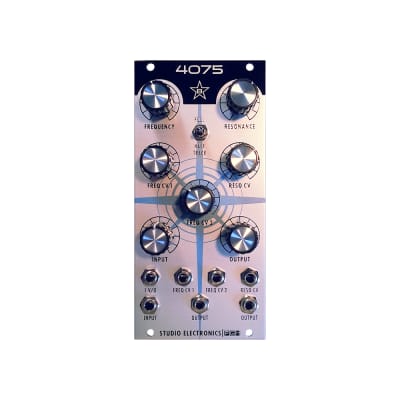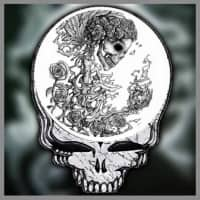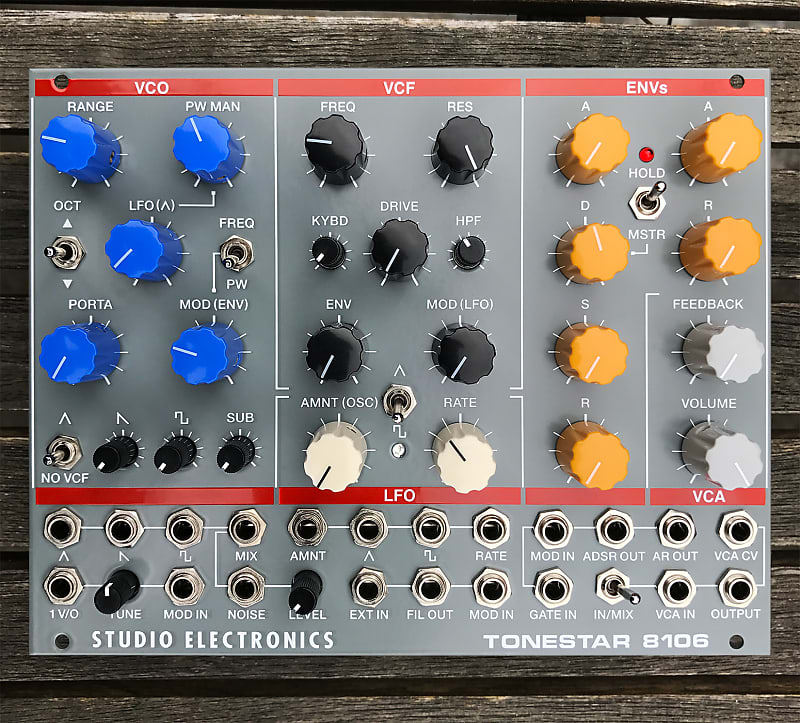


Used for several hours for a recording project then boxed back up and for sale .
TONESTAR 8106, an ARP® 2600-inspired complete synth voice, infuses Tim Caswell's "" filter alchemy—a 6db/oct hi-pass filter followed by a recreation of the Roland IR3109 module—into our platform; this chirpy yet full-bodied 8106 model is also fully # modular featuring 27 pots—one more that the 2600 model for the high-pass filter, 6 switches—one less, sacrificing resonance modulation for that high-pass filtering, and 21 jacks. If the Tone☆ 8106 thins somewhat with resonance excess, route the triangle wave 'round the VCF with the "NO VCF" switch setting, and keep this juicy reimagining of the Roland® IR3109 module boomin' and gloomin'. Nearly thrilling (there)The VCO is the same affair as the Oscillation, the Boomstar, and the Omega. It's kind of a combination of Arp®, Oberheim® and Moog® circuits (sort of a greatest hits), time-tested, very stable—very good tracking over a very large range; certain parts have to be hand selected to achieve that level of exacting performance. Editors Note: This module is a TONESTAR—its own thing—and not a 2600 clone attempt; nevertheless, the Tone☆ tugs lovingly at times on the sleeve of the 1970's era classic.
Envelope FYI: The Tonestar Sustain control replicates the behavior of the 2600 and Odyssey: after the initial Decay, it continues to move (sink) very slowly, adding a little extra texture to the sound. It's technically a flaw, but after digging out my Odyssey, it is for sure a desirable "quirk", and the perfect companion to the 4072 filter (which we mistakenly titled a in the line)
Another bit of fun: The LFO is voltage controlled, so you can envelope, LFO, or otherwise modulate both the rate and the depth; the ADSR amount is also voltage controlled, so it can be manipulated by MIDI dynamics, MIDI volume, an LFO, etc. Greg
[St. Regis] has decreed that anything must be patchable to anything, so some technically wrong patchings (for example, pulse wave out to ADSR out) may often produce unexpectedly interesting, x-mod/notch filtering—quite pleasing effects.
The Tonestar was Greg's concept, but as I understood it, the goal was a single oscillator, 2600 VCF (initially), pre-patched and yet fully modular classic synth voice, at a specific size, wielding every trick we could cram in. Main use would be as a go-to bassline/lead tool, or a premium quality, entry-level, complete synth module, for root-to-leaf sound design, and multiform analog exploration/expression."
27 Knobbed and "Shafted" Potentiometers
VCO: RANGE, PM MAN, LFO (^), PORTA, MOD (ENV), TRIANGLE*, SAW*, SQUARE*, SUB, TUNE; Noise:LEVEL; VCF: FREQ, RES, KBYD, DRIVE, HPF, ENV, MOD (LFO); LFO: AMNT (OSC), RATE; ENVs: (ADSR) ATTACK, DECAY, SUSTAIN, RELEASE, (AR) ATTACK, RELEASE; VCA: FEEDBACK (filter/VCA), VOLUME
* symbol
6 Switches
VCO: OCT (up/null/down); FREQ/PW (frequency/null/pulse width); NO VCF (VCF/null/no VCF); VCF:TRIANGLE*/SQUARE* (triangle/null/square); ENVs: HOLD, MSTR (hold/null/master); VCA: IN/MIX
* symbol
21 Jacks
VCO: TRIANGLE*, SAWTOOTH*, SQUARE*, MIX, 1V/O, MOD IN; NOISE: NOISE (white); LFO: DEPTH, TRIANGLE*, SQUARE*, SPEED; VCF: EXT IN, FIL OUT, MOD IN; ENVs: MOD IN, ADSR OUT, AR OUT, GATE IN; VCA: IN/MIX, VCA IN, OUTPUT
* symbol
All Controls—arranged in order of signal flow—and Patch Points
VCO:
RANGE – Oscillator frequency attenuator.
PW MAN – Variable pulse wave width control.
OCT – +1/-1 octave switch.
LFO (^) – Triangle wave low frequency oscillation to pulse width control.
FREQ/PW – Oscillator frequency, or Pulse (square wave) width to ADSR modulation routing switch. Center off.
PORTA – Slew generator control.
MOD (ENV) – Oscillation modulation via ADSR control.
TRIANGLE*/NO VCF – Triangle to VCA switch—bypasses VCF.
SAWTOOTH* – Sawtooth wave attenuator.
SQUARE* – Square wave attenuator.
SUB – Square wave Sub Oscillator attenuator.
TRIANGLE* – Waveform output.
SAWTOOTH* – Waveform output.
SQUARE* – Waveform output.
MIX – Composite waveform output.
1V/O – One volt per octave control voltage input.
TUNE – Master fine tune (approx. -5/+ 5 semitones).
MOD IN – Modulation CV input. Normaled to ADSR; ADSR is replaced when alt. source connected.
* symbol
Noise:
NOISE – White noise generator output.
LEVEL – Noise attenuator.
VCF:
FREQ - Frequency, or cut-off attenuator.
RESO – Resonance, or Q attenuator.
KYBD – Keyboard/voltage tracking attenuator.
DRIVE – Oscillator output to filter input attenuator.
HPF – High Pass Filter.
ENV – Filter to ADSR envelope attenuator.
MOD (LFO) – Filter to LFO attenuator.
EXT IN – External audio input.
FIL OUT – Filter audio output.
MOD IN – Frequency or Resonance modulation CV input.
LFO:
TRIANGLE/SQUARE* – Waveform select switch (triangle core).
AMNT (OSC) – LFO to Oscillator control.
RATE – Speed or rate attenuator.
AMNT – Control voltage Input.
TRIANGLE* – Triangle wave output.
SQUARE*– Square wave output.
RATE – Speed or rate CV input.
* symbol
ENVs:
A – Attack stage control.
D – Decay stage control.
S – Sustain stage control.
R – Release stage control.
HOLD/MSTR – Indefinite/instant sustain; master mode switch for single ADSR: fuses VCF envelope with VCA envelope. Center off.
A – VCA Attack stage control
R – VCA Release stage control.
MOD IN – Allows for dynamic modulation of the ADSR, eg., if you want the amount of modulation added to/determined by a external source, jack in; or if you prefer, modulation input to the ADSR routing—use with velocity, or a sequencer: the sequencer could isolate the ADSR amount the amount to a single step in the phrase for example. Exciting. A second external envelope can provide an interesting effect, or the AR (in the box patching).
ADSR OUT – ADSR output.
AR OUT – AR Output.
VCA:
FEEDBACK – Oscillator/filter feedback loop control.
VOLUME – Master volume control.
VCA CV – Amplifier control voltage output.
IN/MIX – VCA mix input switch switch (normalled jack). When set to IN, external audio replaces filter output to VCA; when set to mix MIX, filter output is fed along with the filter audio to VCA.
VCA IN – Audio input.
OUTPUT – Main output.
Vitals
PCB Mounting Scheme - Through-hole.
Filter - A 6db/oct hi-pass filter followed by a recreation of the Roland® IR3109 module, which is a 4 pole, 24 db/oct voltage controlled lowpass filter with voltage controlled resonance. 3 dual OTAs with similar topology to the BA662 used in the Jupiter 8 (and the IR3109 module) were employed, 1 amp for the hi-pass filter, 4 (with added buffers) for the low-pass, and 1 for the resonance. This filter takes a wide range of input signals, and tracks control voltage extremely well. Tap points are available for 6db, 12db, and 18db/oct. Although the topology is similar to the 4072, the tonality, especially when over driven, is distinct.
Size - 32hp.
Depth - 35mm including connectors.
Power Usage - 130mA, 80mA (+12 / -12)
Reverb Buyer Protection
Reverb has your back if your item is lost, damaged, or doesn't match its description. Simply report any issues within 7 days and we'll help you get a full refund.Learn more about Reverb Buyer Protection.
| Listed | 6 years ago |
| Condition | Mint (Used) Mint items are in essentially new original condition but have been opened or played.Learn more |
| Brand | |
| Model |
|
| Categories |
